Frustration bubbles up when those tiny seeds you lovingly planted indoors refuse to sprout. That dream of a lush garden, started early right on your windowsill, crashes down before spring even arrives.
Many aspiring gardeners face this disheartening cycle: money wasted, time spent, and zero payoff. You’re ready to ditch the struggle and finally experience the undeniable thrill of nurturing a plant from a mere speck to a thriving seedling.
This isn’t about guesswork or complicated setups. We’re cutting straight to the chase, revealing the absolute easiest, most foolproof seeds to start indoors—the ones practically guaranteed to pop up and flourish.
Get ready to transform your indoor space into a vibrant nursery and step into the spring planting season with robust, ready-to-go plants, leaving past disappointments behind for good.
1. Lettuce

Small tray of romaine lettuce seedlings can tell you a lot about why some seeds grow with almost no fuss. Fresh green leaves rise from rich soil, each one looking strong and healthy without much effort from the grower.
These seedlings respond fast to indoor conditions because romaine tends to sprout in a few days with steady moisture and soft, filtered light. You can see how evenly they grow, showing how forgiving this seed can be for beginners who want quick wins.
The sturdy texture of the leaves signals that the plants are getting what they need without complicated setups. Many gardeners love starting romaine indoors because it lets them harvest tender greens earlier in the season.
It also saves space since trays like this fit on shelves, window sills, or under simple grow lights. Watching these trays thrive gives new growers confidence to start more seeds and build momentum. It’s a small reminder that some crops truly make indoor gardening feel easy and rewarding.
2. Spinach

Bright green spinach seedlings crowd this tray, showing how simple indoor seed starting can feel. Each slender stem reaches for the window light, proving that a sunny sill and moist soil are often all you need.
In small spaces, trays like this turn a plain ledge into a steady supply of baby greens. Many beginners pick spinach because it germinates quickly and forgives small mistakes with watering or light.
You can sow the seeds thick, enjoy them as tender sprouts, then replant another tray for a steady rotation. The nearby clay pots hint at how flexible spinach is, growing happily in almost any container with drainage.
Watching these seedlings rise day after day builds confidence and keeps motivation high for new gardeners. You learn how much moisture the soil likes just by touching it and checking your plants.
Soon the tray becomes a daily habit, a quick stop to snip a handful of leaves for salads, omelets, or smoothies. Indoor gardening starts to feel less like a project and more like a calming routine you look forward to.
3. Kale
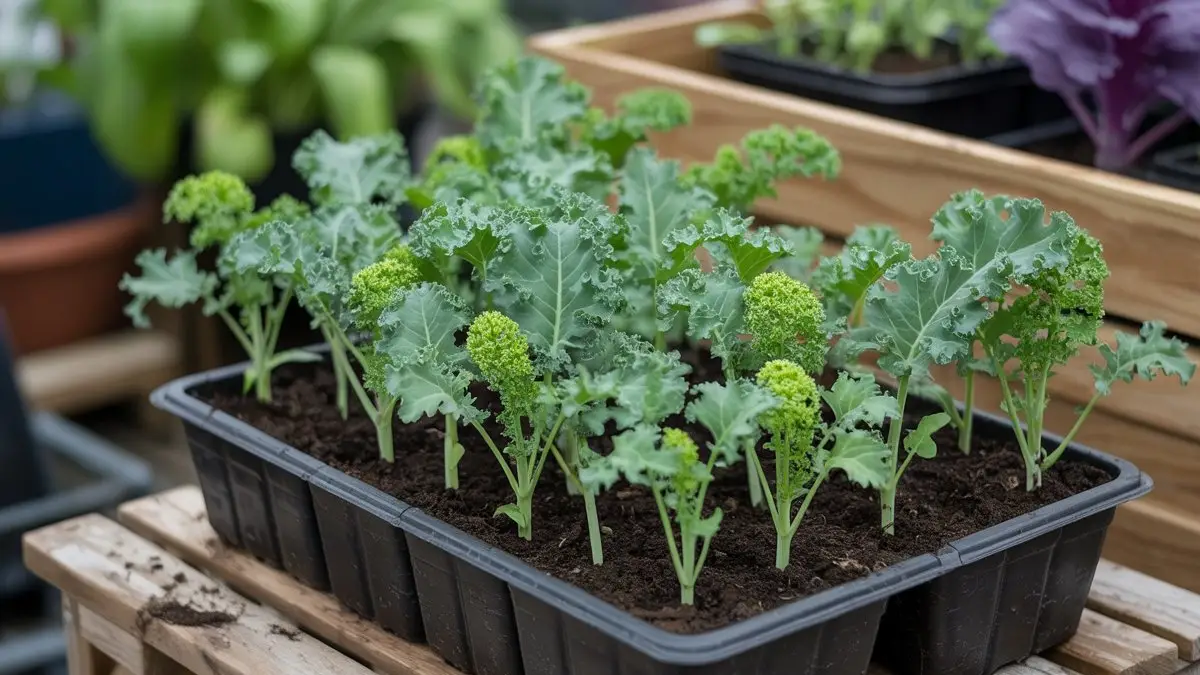
Curly kale seedlings fill this tray with a lively mix of ruffled leaves and sturdy stems, showing why kale ranks among the easiest seeds to begin indoors. Each plant stands tall with that familiar crinkled texture, hinting at how quickly this crop responds once it has steady moisture and a bit of warmth.
Simple trays like this make indoor growing feel relaxed, since kale rarely complains about cooler rooms or light that shifts during the day. You can see how evenly the seedlings develop, creating a tidy row of plants that promise a generous harvest later on.
Many new growers choose kale because it sprouts fast and stays strong through early mistakes. These young plants make daily care almost calming, since checking soil and watching new leaves form becomes a small routine you look forward to.
As the seedlings grow, they build confidence and encourage gardeners to try even more varieties. Indoors or out, kale shows how rewarding seed starting can be with just a little attention and a bright spot in your home.
4. Swiss Chard
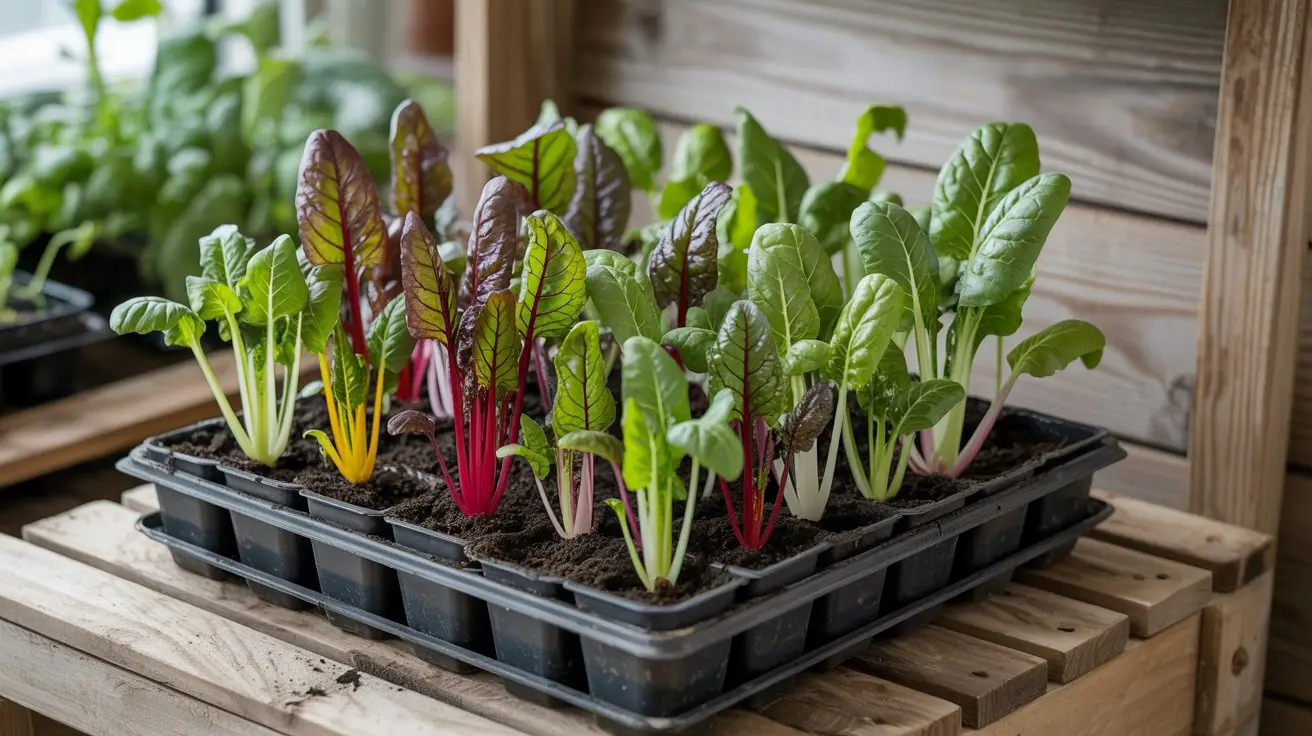
Bright stems in red, yellow, and soft pink lift glossy green leaves from each cell of this tray, showing how easy indoor seed starting can feel. Here you can see how fast Swiss chard responds once it has moist soil and steady light.
In a small space, a tray like this adds color to a windowsill long before the garden outside wakes up. You simply sow the seeds, keep the mix damp, and watch those neon stems appear in a week or so. Beginners love this crop because it handles cooler rooms and small watering mistakes without much complaint.
Each seedling grows into a sturdy plant that you can harvest leaf by leaf for salads and sautés. The mix of colors keeps the routine fun and encourages you to check on growth every day. Growing Swiss chard indoors builds confidence and gives you fresh greens long before planting time outdoors.
5. Basil

Glossy basil seedlings crowd this tray, catching every bit of light that spills through the nearby window and turning it into fresh growth. Each stem looks sturdy yet soft, showing how fast basil responds once the soil stays warm and slightly moist.
In a small kitchen or apartment, a simple tray like this can supply fragrant leaves long before outdoor beds are ready. New gardeners often choose basil because the seeds sprout quickly and give a clear signal when they need water, leaves droop a little then bounce back after a drink.
You can tuck several seeds into each cell, thin them with a gentle pinch, and enjoy that classic scent on your fingers. Soon snipping a handful for pasta, salads, or homemade pesto becomes part of the cooking routine.
For anyone nervous about starting seeds, this kind of setup turns the process into something calm and friendly. Growing basil indoors builds confidence and makes the whole home smell like a fresh herb garden.
6. Cilantro
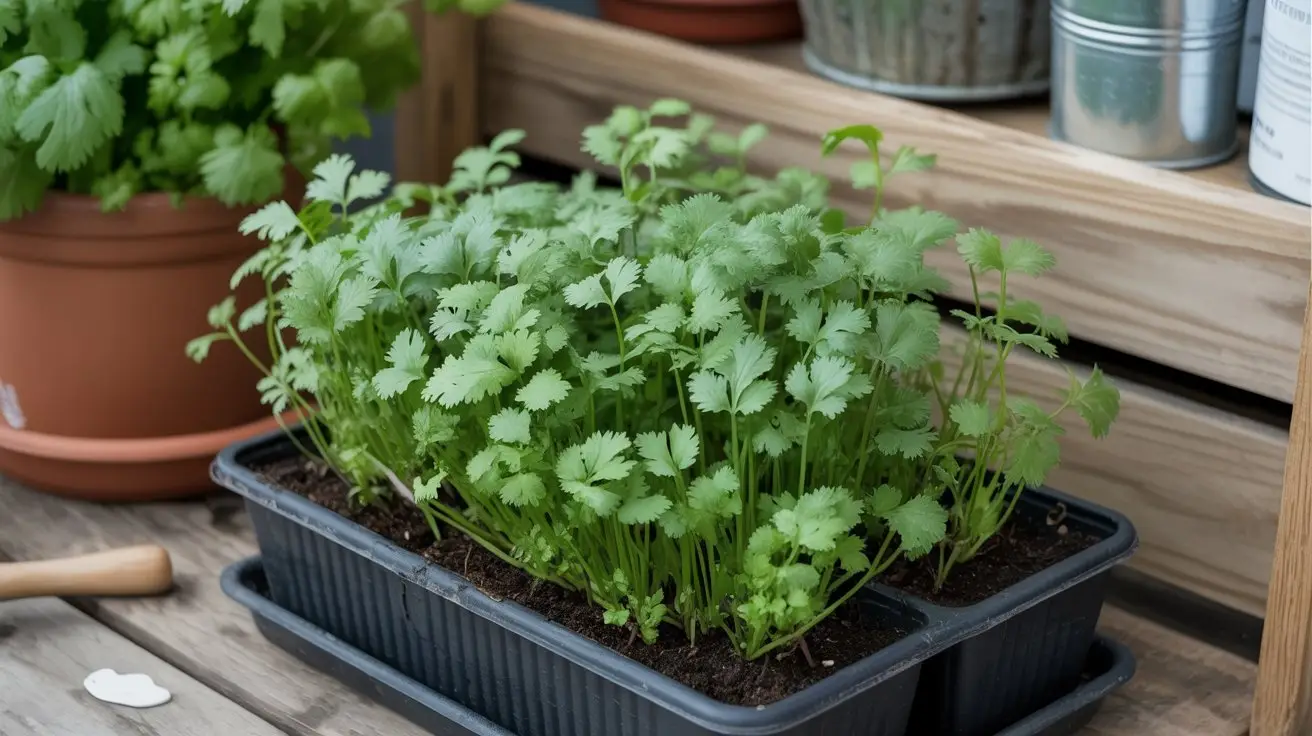
Soft green cilantro leaves fill this tray with a gentle, feathery look that makes indoor seed starting feel easy and calm. Each stem rises tall and light, showing how quickly cilantro responds once it has steady moisture and a bright spot to grow.
Many beginners reach for cilantro seeds because they sprout in small clusters and don’t demand complicated steps. You can sow them thick, keep the soil damp, and watch the tray turn into a small herb patch within a couple of weeks.
The scent alone adds a lift to your kitchen, especially when you pinch a few leaves for salsa, soups, or garnish. Some seedlings lean slightly toward the light, reminding you to turn the tray now and then for even growth.
Growing cilantro indoors builds confidence since the plants keep producing new leaves with regular picking. A setup like this proves that you don’t need a large garden to enjoy fresh herbs every day.
7. Mint
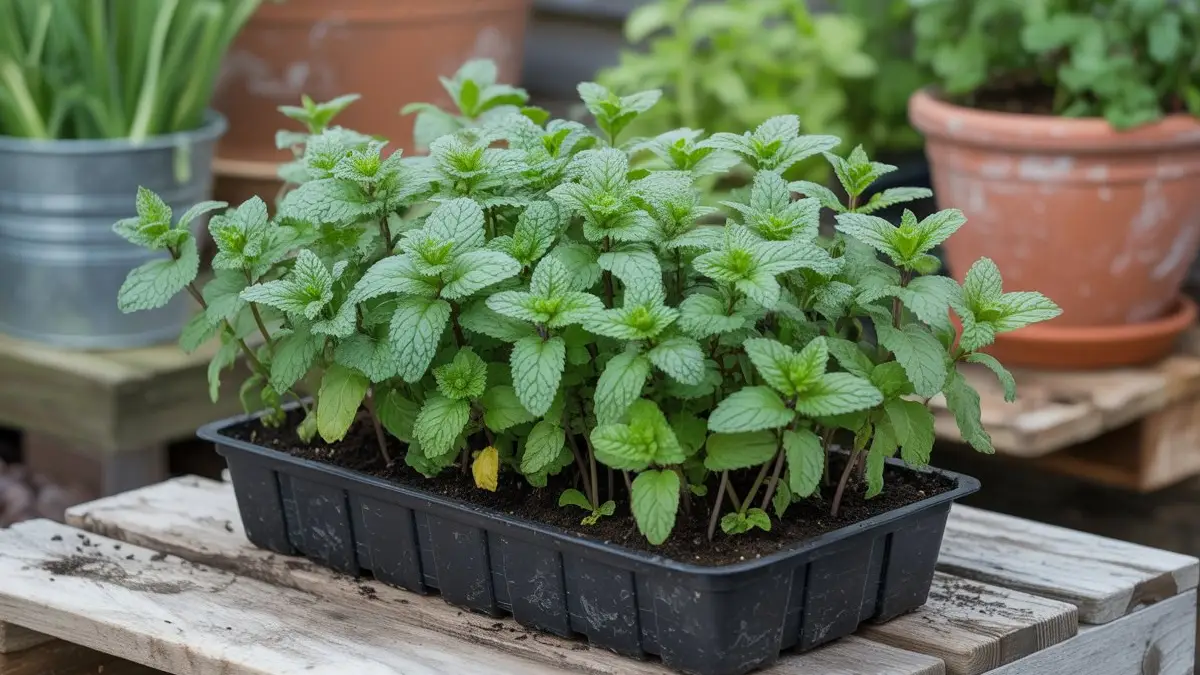
Bright mint seedlings crowd this tray, leaves lifted as if they are already scented with cool sweetness. Each stem rises from dark soil, showing how easy it is to turn a small corner of your home into a homegrown tea garden.
Inexpensive seeds and a shallow container are all you really need to get started. First you sprinkle the seeds, cover them with a light layer of mix, then keep the surface moist with a gentle mist.
Soon tiny pairs of leaves appear, followed by that classic crinkled texture that hints at strong flavor. New gardeners often feel nervous about timing, yet mint forgives late watering and small changes in light.
Plants spread in the tray, filling gaps and creating a dense patch that begs to be snipped. A handful of stems can go into iced drinks, desserts, or simple infused water on busy days.
Growing mint indoors adds a clean scent to the room and a small daily ritual as you check growth and remove a few leaves. This tray proves that some seeds reward even the most casual care with generous, fresh harvests.
8. Parsley

A low metal dish packed with feathery parsley greens shows how simple indoor seed starting can feel when you choose forgiving seeds. Tiny stems rise closely together, forming a soft mound of herbs that almost spills over the edge of the container.
From a gardener’s point of view, this little forest began with a quick sprinkle of seeds across moist potting mix and a gentle press of the hand. After that, steady light and regular misting did most of the work.
New growers appreciate parsley because the seeds may take a bit longer to sprout, yet once they appear the plants stay sturdy and patient. Each day brings a little more height and a deeper shade of green.
One snip of scissors near the base gives you a handful of fresh flavor for soups, eggs, and grain bowls. The shallow dish fits on any table or sill, turning unused space into a productive herb patch.
Knowing you can raise this much greenery from one small sowing builds confidence and makes the idea of starting more indoor seeds feel easy and reachable.
9. Green Onions
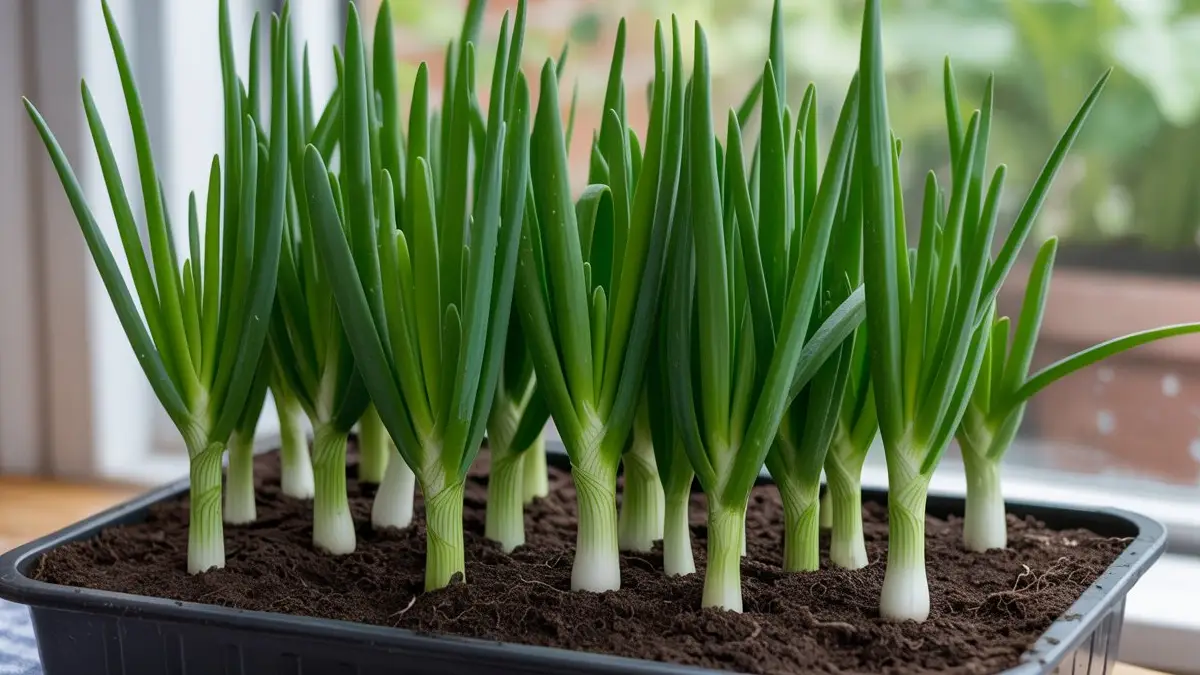
Bright green onion tops stand like a tiny forest in this tray, showing how simple it can be to grow fresh flavor on a windowsill. Each plant has a pale white base that sits snug in the soil, then shoots straight upward into crisp leaves that almost glow in the light.
For new gardeners, green onions are an easy first choice because the seeds sprout fast and grow well in crowded trays. A basic container, loose potting mix, and a sunny window are usually enough to keep them happy.
You can trim the tops often for salads, soups, and stir fries, and they will keep sending up new growth. Watching these neat rows get taller day by day turns seed starting into a small daily pleasure.
The clean scent that rises when you snip a handful reminds you how rewarding indoor growing can feel. A tray like this proves that quick kitchen harvests are possible even in a small home.
10. Peas

Morning light washes over this tray of tomato seedlings, turning each slender stem into a small promise of summer harvests. Dozens of sprouts stand in neat rows, their first true leaves just unfolding as they reach toward the window.
From a seed starter’s view, this is one of the easiest indoor projects to try. A tray with individual cells, loose seed mix, and a sunny sill are usually all you need for strong germination.
After sowing the seeds, you keep the soil lightly moist and watch the first green hooks appear in a week or so. Soon the tray fills with sturdy little plants that lean together like a tiny forest.
New gardeners gain confidence here, learning how to brush a hand gently over the tops to encourage stocky growth and prevent legginess.
Each seedling can later move into a bigger pot or out into the garden, already adapted to your home’s light and care routine. Growing tomatoes from seed indoors turns a simple windowsill into the starting line for an entire season of fresh fruit.
11. Radish
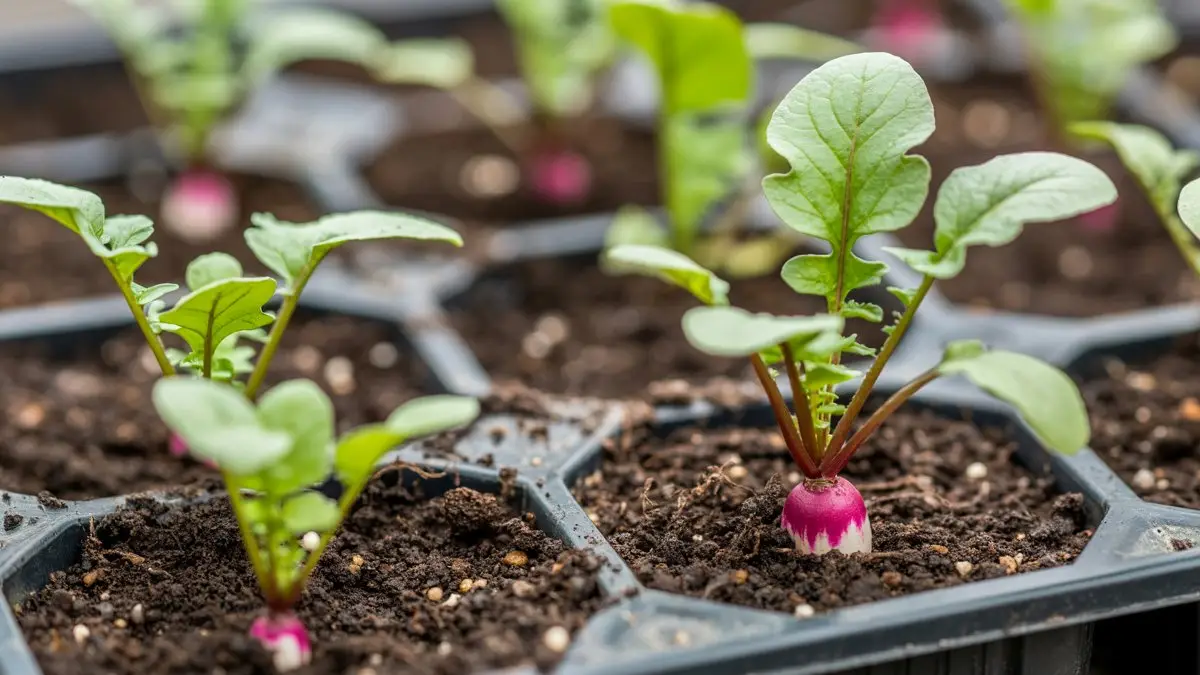
Small pink and white radish bulbs peek out of the soil in this seed tray, already showing color while the leaves are still young and tender. Each plant stands in its own cell, which makes spacing and watering simple even for someone just learning how to start seeds indoors.
From the first sprinkle of seed to this stage usually takes only a few weeks, so results come fast and keep motivation high. You can see how the roots swell above the soil line, giving a clear signal that harvest time is close.
Many new gardeners appreciate radishes because they tolerate cool rooms, need only moderate light, and still reward you with crisp roots for salads and snacks. A loose potting mix, gentle watering, and a bright window are usually enough.
Trays like this fit on shelves or counters and turn small spaces into productive mini gardens. Growing radishes from seed indoors teaches timing, thinning, and basic care in a friendly way that builds confidence for the next crop.
12. Beets
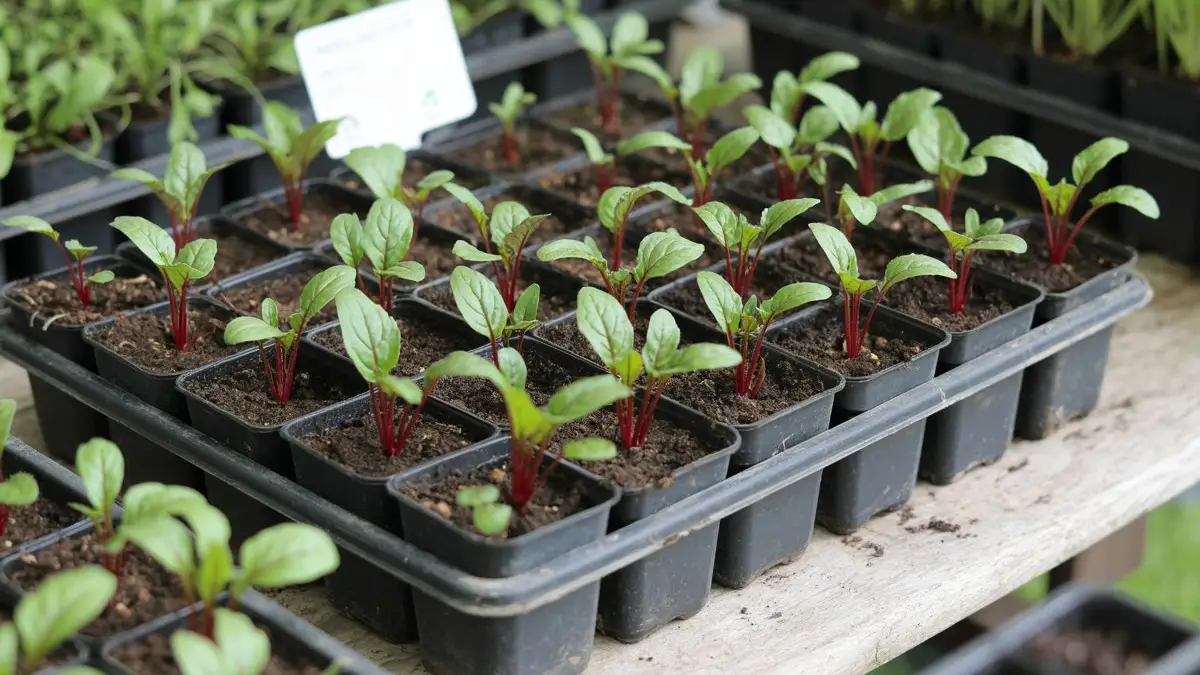
Bright red stems and glossy green leaves fill each small cell in this tray, showing how easy beet seeds can be for indoor beginners. Every plant stands in its own pocket of soil, so watering and spacing stay simple and stress free.
After sowing, you cover the seeds lightly, keep the mix moist, and soon little red veins appear along those first leaves. Many new gardeners like beets because the seeds sprout in cool rooms and grow well in compact trays on a shelf or near a bright window.
You can thin the seedlings by snipping extras for salads, then let the remaining plants mature into tender roots once they move outside or into deeper pots. Each day brings a little more height and color, which keeps you checking progress and learning what healthy growth looks like.
A setup like this turns a plain table into a mini nursery and proves that crisp, homegrown beets can start from just a handful of seeds and a simple tray indoors.
13. Tomato

Rows of tomato seedlings stretch across this tray, turning a simple table into a busy little nursery for anyone learning the easiest seeds to start indoors for guaranteed success.
Each plant stands tall on a slim stem, already covered in soft fuzz that hints at strong growth ahead. Here you can see how individual cells keep roots separate and make watering gentle and controlled.
In this tray the soil stays evenly moist, so beginners do not have to guess much about timing. Many gardeners like starting tomatoes inside because the seeds wake up fast in warm potting mix and bright light.
As you water and turn the tray, the seedlings lean toward you and grow stockier every day. Soon they are ready to move into larger pots, already used to your home and care routine.
Starting tomatoes from seed indoors gives you more variety, more control, and a satisfying feeling each time you check on this green grid of future harvests.
14. Peppers
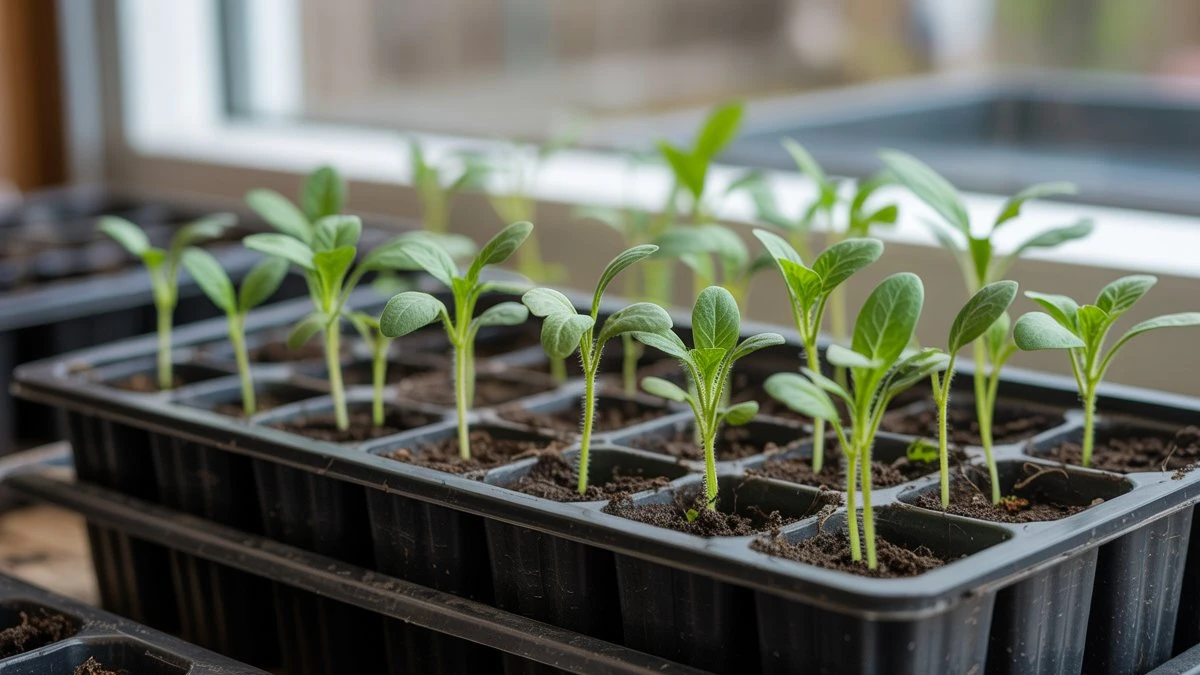
Young zucchini seedlings stand in neat rows in this tray, each one lifting soft green leaves toward the nearby window light. From a gardener’s point of view, this is one of the easiest seeds to start indoors for guaranteed success because the seeds are large, simple to handle, and quick to sprout.
After pushing each seed into loose potting mix and watering gently, you only need steady warmth and bright light to see these sturdy stems appear. Every cell gives the roots space, so plants grow straight and strong instead of crowded and weak.
New growers love zucchini because early growth moves fast enough to stay exciting, yet the plants forgive small mistakes with watering. You can watch the first true leaves unfold, then start planning where each seedling will go once outdoor soil warms.
A tray like this turns a spare table into a mini nursery and teaches the basics of moisture, light, and airflow in a very friendly way. Before long, these small plants will be ready to move into larger pots or garden beds, already tuned to your care routine and home environment.
15. Zinnia

Bright zinnia blooms in shades of pink, coral, and orange rise from a shallow wooden bowl, showing how easy it can be to start flower seeds indoors for guaranteed success.
Each plant stands on a sturdy stem with clean green leaves, proof that a sunny window and regular watering are often enough. From a gardener’s point of view, zinnia seeds feel friendly because they are large, simple to handle, and quick to sprout in warm potting mix.
You tuck each seed into the soil, keep the surface slightly moist, and soon pairs of leaves appear like small paddles. As the plants grow, tight buds form and then open into layered petals that brighten the whole room.
New growers gain confidence each time a new bloom appears, since the plants respond quickly to light and water. A bowl like this fits on a desk or kitchen table and turns everyday moments into small garden visits.
Seeing such rich color from a handful of seeds makes it tempting to start another tray and fill more corners of the home with easy indoor flowers.
16. Marigold

Feathery marigold seedlings stand in tight rows in this tray, their lime green tops glowing against the dark soil. Each plant rises on a slim red stem, showing how quickly these easy seeds respond once they get warmth and steady moisture.
Here you can see why marigolds belong on any list of the easiest seeds to start indoors for guaranteed success. From a gardener’s point of view, the routine stays simple.
You tuck one or two seeds into each cell, press the mix gently, and keep the surface just damp with a mist bottle. Soon a soft carpet of foliage appears and then stretches upward toward the light.
New growers appreciate how marigolds forgive small mistakes with watering and give clear signals when they need more sun.
The tray turns an ordinary shelf into a nursery that will later supply pots, beds, and borders with bright, pest friendly flowers. Watching this little forest grow brings a quiet sense of progress long before the first blooms open.
17. Calendula
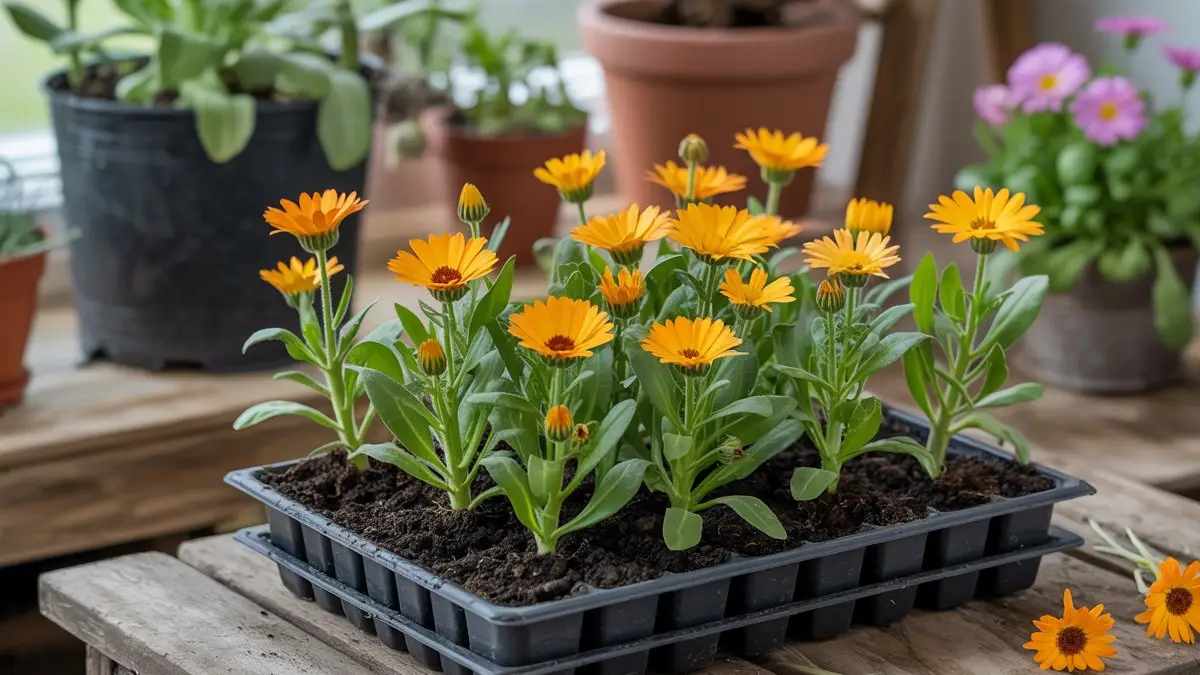
Golden calendula flowers light up this seed tray, turning a simple corner of the house into a tiny indoor cutting garden. Bright petals surround dark centers, while sturdy green stems rise from rich soil that still shows the imprint of recent watering.
From a gardener point of view, this scene proves how friendly calendula seeds are for beginners who want easy wins. You scatter the seeds, cover them with a thin layer of mix, and keep the surface moist until the first soft leaves appear.
Soon buds form along the stems and open into cheerful blooms that seem to smile back at the window light. New growers love this plant because it tolerates cooler rooms, bounces back after occasional dry spells, and keeps sending up fresh flowers with regular deadheading.
A tray like this fits on a bench or wide sill and fills the room with color long before the outdoor beds warm up. Seeing so many blooms from one early sowing makes the idea of starting more indoor seeds feel exciting and very achievable.
18. Nasturtium
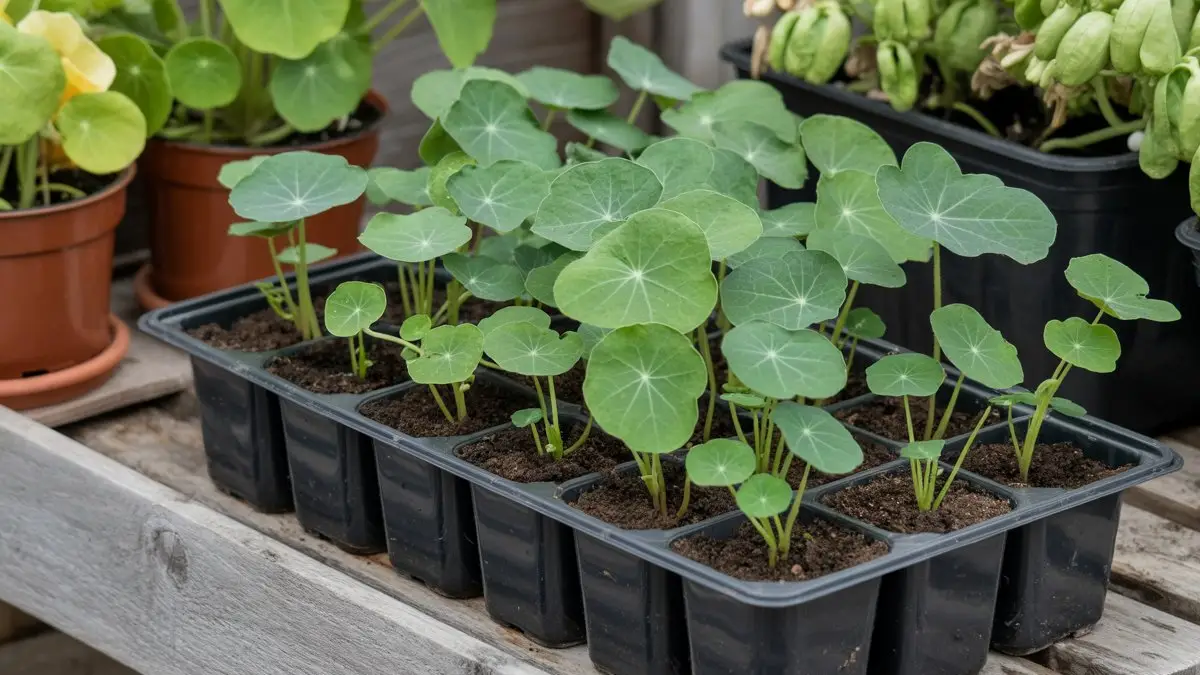
Round shield like leaves fill this tray of nasturtium seedlings, each one lifted on a slim stem so the veins catch the light. At first glance it looks like a tiny forest of saucers, and that playful shape is part of what makes nasturtiums such friendly seeds for new indoor gardeners.
Seeds are large and easy to handle, so you simply tuck one into each cell, press the soil gently, then water until the mix feels evenly moist. In only a short time, sprouts push through and unfurl these soft green discs that keep getting bigger every day.
Some plants lean toward the nearest window, reminding you to turn the tray and keep growth even. New growers love nasturtiums because they accept cooler rooms, do not fuss about small misses with watering, and later reward you with edible flowers and leaves.
A tray like this turns a plain bench into a little seed starting classroom, teaching how light, moisture, and space work together while still feeling calm and manageable.
19. Cosmos

Soft feathery foliage rises from this tray of cosmos, topped with cheerful blooms in pink, white, and deep magenta. At a glance it shows how the easiest seeds to start indoors for guaranteed success often bring fast color as well as growth.
You scatter the seeds on loose potting mix, press them in gently, then keep the soil moist and warm. Soon thin stems appear and stretch upward, carrying delicate leaves that look like green lace.
Each morning more buds swell and open, so the tray changes a little every time you walk past. New gardeners enjoy cosmos because the plants forgive missed waterings and stand tall even in simple containers.
A windowsill, sunroom, or sheltered porch can host a whole mini meadow like this. Seeing so many blooms in one shallow tray builds confidence and makes the idea of starting more flower seeds feel easy.
In time these young plants can move into the garden, but for now they already turn a plain bench into a bright indoor landscape.
20. Sunflower
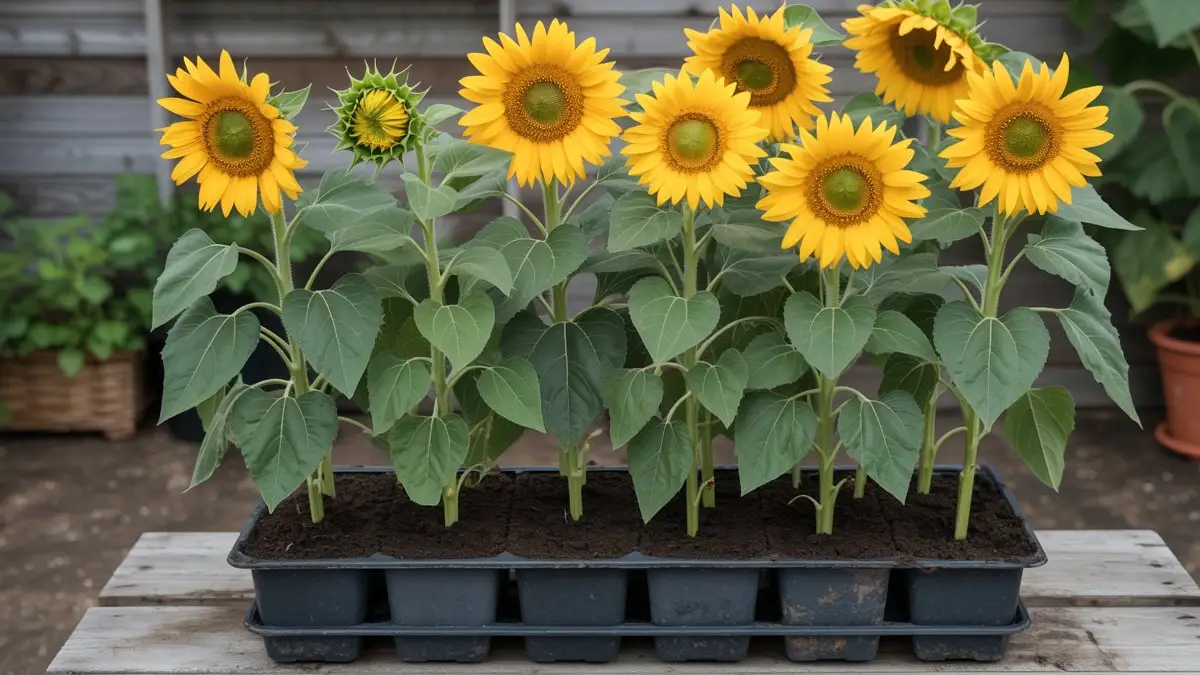
Bright golden sunflower faces line this tray like a row of tiny suns, each one rising from sturdy green stems that crowd the rich soil in a cheerful way. From a home gardener point of view, this scene shows why sunflower seeds belong on any list of the easiest seeds to start indoors for guaranteed success.
Large seeds are easy to handle, so you press them into loose potting mix, water slowly, then wait just a short time before strong sprouts appear. Soon thick stems and wide heart shaped leaves fill the tray, and flower buds form almost before you expect them.
New growers enjoy how clearly these plants respond to light, turning their faces toward the brightest window and reminding you to rotate the tray now and then. Even in a small space, a setup like this delivers bold color, daily growth, and a sense of real progress.
Later these sturdy plants can move into larger pots or out into the garden, already adapted to your care and ready to keep blooming through warm weather.
21. Cucumber

Tall cucumber seedlings crowd this tray, their heart shaped leaves overlapping like little umbrellas above the dark soil, while two small cucumbers rest nearby as a promise of what is coming.
For anyone searching the easiest seeds to start indoors for guaranteed success, cucumbers feel friendly from day one. Seeds are large, easy to see in your hand, and they germinate fast in warm potting mix.
After tucking one into each cell and watering gently, you soon notice thick stems pushing upward and sending out these broad leaves that drink in the light. A sunny windowsill or a simple grow light keeps them happy and growing at a steady pace.
Some vines already show tiny yellow blooms, proof that roots have settled and growth is strong. New gardeners appreciate how cucumbers quickly respond to regular watering and light, so small changes in care are easy to spot and learn from. Trays like this turn a plain table into a mini greenhouse and make homegrown salads feel close at hand.

